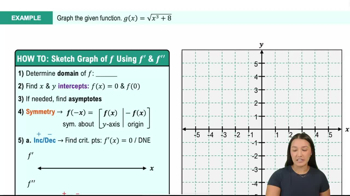Table of contents
- 0. Functions7h 52m
- Introduction to Functions16m
- Piecewise Functions10m
- Properties of Functions9m
- Common Functions1h 8m
- Transformations5m
- Combining Functions27m
- Exponent rules32m
- Exponential Functions28m
- Logarithmic Functions24m
- Properties of Logarithms34m
- Exponential & Logarithmic Equations35m
- Introduction to Trigonometric Functions38m
- Graphs of Trigonometric Functions44m
- Trigonometric Identities47m
- Inverse Trigonometric Functions48m
- 1. Limits and Continuity2h 2m
- 2. Intro to Derivatives1h 33m
- 3. Techniques of Differentiation3h 18m
- 4. Applications of Derivatives2h 38m
- 5. Graphical Applications of Derivatives6h 2m
- 6. Derivatives of Inverse, Exponential, & Logarithmic Functions2h 37m
- 7. Antiderivatives & Indefinite Integrals1h 26m
- 8. Definite Integrals4h 44m
- 9. Graphical Applications of Integrals2h 27m
- 10. Physics Applications of Integrals 2h 22m
5. Graphical Applications of Derivatives
Curve Sketching
Problem 4.4.14g
Textbook Question
if ƒ(x) = 1 / (3x⁴ + 5) , it can be shown that ƒ'(x) = 12x³ / (3x⁴ + 5)² and ƒ"(x) = 180x² (x² + 1) (x + 1) (x - 1) / (3x⁴ + 5)³ . Use these functions to complete the following steps.
g. Use your work in parts (a) through (f) to sketch a graph of ƒ .
 Verified step by step guidance
Verified step by step guidance1
Step 1: Identify the critical points of the function ƒ(x) by setting the first derivative ƒ'(x) equal to zero and solving for x. This will help determine where the function has local maxima, minima, or points of inflection.
Step 2: Analyze the sign of ƒ'(x) around the critical points to determine the intervals where the function is increasing or decreasing. This will help in understanding the behavior of the function on different intervals.
Step 3: Use the second derivative ƒ"(x) to determine the concavity of the function. Set ƒ"(x) equal to zero to find potential inflection points, and analyze the sign of ƒ"(x) around these points to determine where the function is concave up or concave down.
Step 4: Consider the asymptotic behavior of the function. Since ƒ(x) is a rational function, examine the behavior as x approaches positive and negative infinity, as well as any vertical asymptotes that may occur when the denominator is zero.
Step 5: Combine the information from the critical points, intervals of increase/decrease, concavity, and asymptotic behavior to sketch the graph of ƒ(x). Ensure that the graph reflects all the analyzed characteristics, such as local extrema, inflection points, and asymptotes.
 Verified video answer for a similar problem:
Verified video answer for a similar problem:This video solution was recommended by our tutors as helpful for the problem above
Video duration:
8mPlay a video:
Was this helpful?
Key Concepts
Here are the essential concepts you must grasp in order to answer the question correctly.
Derivative
The derivative of a function measures how the function's output changes as its input changes. It represents the slope of the tangent line to the graph of the function at any given point. In this case, the first derivative ƒ'(x) indicates the rate of change of the function ƒ(x) = 1 / (3x⁴ + 5), which is crucial for understanding the function's behavior, including increasing and decreasing intervals.
Recommended video:

Derivatives
Second Derivative
The second derivative of a function, denoted as ƒ''(x), provides information about the curvature of the graph of the function. It indicates whether the function is concave up or concave down at a given point. In this context, analyzing the second derivative helps identify points of inflection, where the graph changes its concavity, which is essential for sketching an accurate graph of ƒ.
Recommended video:

The Second Derivative Test: Finding Local Extrema
Graph Sketching
Graph sketching involves using information from the function and its derivatives to create a visual representation of the function's behavior. This includes identifying critical points, intervals of increase and decrease, concavity, and asymptotic behavior. By applying the first and second derivatives of ƒ(x), one can effectively outline the shape of the graph, including local maxima, minima, and points of inflection.
Recommended video:

Summary of Curve Sketching

 11:41m
11:41mWatch next
Master Summary of Curve Sketching with a bite sized video explanation from Callie
Start learning



